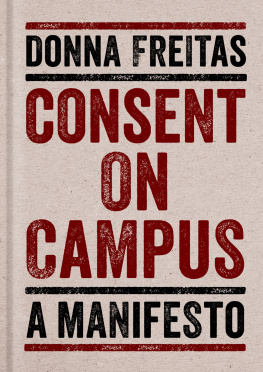William T. O’Donohue - Handbook of Sexual Assault and Sexual Assault Prevention
Here you can read online William T. O’Donohue - Handbook of Sexual Assault and Sexual Assault Prevention full text of the book (entire story) in english for free. Download pdf and epub, get meaning, cover and reviews about this ebook. year: 2019, publisher: Springer International Publishing, genre: Home and family. Description of the work, (preface) as well as reviews are available. Best literature library LitArk.com created for fans of good reading and offers a wide selection of genres:
Romance novel
Science fiction
Adventure
Detective
Science
History
Home and family
Prose
Art
Politics
Computer
Non-fiction
Religion
Business
Children
Humor
Choose a favorite category and find really read worthwhile books. Enjoy immersion in the world of imagination, feel the emotions of the characters or learn something new for yourself, make an fascinating discovery.
- Book:Handbook of Sexual Assault and Sexual Assault Prevention
- Author:
- Publisher:Springer International Publishing
- Genre:
- Year:2019
- Rating:5 / 5
- Favourites:Add to favourites
- Your mark:
- 100
- 1
- 2
- 3
- 4
- 5
Handbook of Sexual Assault and Sexual Assault Prevention: summary, description and annotation
We offer to read an annotation, description, summary or preface (depends on what the author of the book "Handbook of Sexual Assault and Sexual Assault Prevention" wrote himself). If you haven't found the necessary information about the book — write in the comments, we will try to find it.
Handbook of Sexual Assault and Sexual Assault Prevention — read online for free the complete book (whole text) full work
Below is the text of the book, divided by pages. System saving the place of the last page read, allows you to conveniently read the book "Handbook of Sexual Assault and Sexual Assault Prevention" online for free, without having to search again every time where you left off. Put a bookmark, and you can go to the page where you finished reading at any time.
Font size:
Interval:
Bookmark:


This Springer imprint is published by the registered company Springer Nature Switzerland AG
The registered company address is: Gewerbestrasse 11, 6330 Cham, Switzerland
Any field of science is not without its controversies and the field of sexual assault research is no exception. This section will provide an overview of eight important but controversial issues in the contemporary sexual assault field. Further research that provides a basis for increased understanding and perhaps resolving these controversies represents an important path forward for advancing the science around sexual assault and sexual assault prevention.
Epidemiology is the scientific study of the incidence and prevalence of health problems. Incidence is defined as the frequency of new cases of the phenomenon and is usually given with respect to both a specific time-period, e.g., the incidence of sexual assault in a one-year period would be the rate of new cases of sexual assault in that time-period; as well as by the size of the population, e.g., the incidence of sexual assault is x within a year for the y million female undergraduate students in the United States. Prevalence, on the other hand, is the number of cases that are current, which is a combination of new cases plus previous cases. Prevalence in some sense is a cumulative numberwith lifetime prevalence providing just thatthe frequency of sexual assault occurring sometime in an individuals life.
Obviously, within the epidemiology of sexual assault there are a number of complex issues that need to handled well to derive accurate numbers: (a) how sexual assault is definede.g., does any sort of unwanted sexual contact count, e.g., does an unwanted kiss on a date count just as does forced vaginal penetration, or does an inappropriate touching of a chest when 5 by a 4-year-older sibling count as a case of sexual assault (or should it count as child sexual abuse, a different phenomenon, or as problematic sex play?) Sexual assault can be a vague term and it is useful to be more specific and clear about how this term is operationalizede.g., is penetration involved in the statistic or simply any unwanted touching? One reason so many incidences are not reported as assault is that the recipient does not label them as such. Others indicate that the incidents are not significant enough to be reported (e.g., an unwanted kiss on a date). Perhaps other distinctions between sexual assault and unwanted sexual touching are needed something like unwanted minor sexual advances during a date. The latter are in no way being excused or condonedjust distinguished from something that is more serious. Second, should every self-report of sexual assault count as a true incidence or should some sort of screen or some sort of additional burden of proof be met, i.e., only founded cases that involve some sort of positive finding from some sort of reasonable investigation are included in the statistic? Should reported cases be used, or should self-report data of unreported cases also be used; or both? If formal reports of sexual assault are used, how does one deal with the fact that many self-reported instances of unwanted sexual contact are never formally reported at all: does one include in these epidemiological numbers only reported cases (assuming all are true), or does one take some sort of estimate of the number of unreported cases (e.g., only one in 16 cases is reported; therefore, every reported case is multiplied by 16) and use this estimate to calculate incidence or prevalence? A further nuance to this issue is that Koss and colleagues (1987) in a classic study found that the report of sexual assault is subject to a number of important methodological variables such as the wording of questions (use of the word rape vs. use of something like unwanted sexual contact) as well as assessment strategy (face to face interviews vs. questionnaires) and thus these methodological characteristics can influence the epidemiological numbers reported.
An American Association of University survey indicated that 1 in 4 women will be victims of sexual assault or misconductwhich can be taken as evidence of this commonly reported prevalence rate. However, those reporting penetration was 10.8%and thus if penetration is taken to be a definitional criterion of rapethis rate decreases from 1 in 4 to 1 in 9.
One in five women and one in 71 men will be raped at some point in their lives (a) (National Sexual Violence Center (nsvc.org). This organization also states on the same website: One in 5 women and one in 16 men are sexually assaulted while in college (i), which would problematically imply given the first statistic no woman will be raped after she graduates from college or that the rate of sexual assault in college is substantially greater than the general population).
However, in a study of college-age females between the years of 1995 and 2014 Sinozich and Langton (2014) found that the incidence of rape and sexual assault was 7.6 per 1000 for nonstudents and for students 6.1 per 1000a rate of about 1 in 164. This is obviously quite different than 1 in 4.
It is not the purpose of this section to clear up the numerous and complex controversies concerning the epidemiology of sexual assault. It is to say, however, that in science as well as any rational debate, accuracy and clarity are desirable characteristics. Perhaps the function of the phrase 1 in 4 women will be raped is to have an important and desirable rhetorical function: individuals ought not to minimize this problem; it is a problem that ought to be taken seriously: sexual assault clearly occurs all too frequently. However, the persuasive and informative function ought to be achieved with accurate numbers with clearly defined terms. Moreover, there does not seem to be any cutoff that sexual assault advocates ought to be worried about, e.g., no one has argued that if only 1 in 200 individuals are sexually assaulted the problem is then unimportant. Scholars in the field are encouraged to use accurate numbers and precise terms regarding the incidence and prevalence of sexual assault, communicate assumptions or problems with these numbers, so that only clear accurate information is being disseminated.
Font size:
Interval:
Bookmark:
Similar books «Handbook of Sexual Assault and Sexual Assault Prevention»
Look at similar books to Handbook of Sexual Assault and Sexual Assault Prevention. We have selected literature similar in name and meaning in the hope of providing readers with more options to find new, interesting, not yet read works.
Discussion, reviews of the book Handbook of Sexual Assault and Sexual Assault Prevention and just readers' own opinions. Leave your comments, write what you think about the work, its meaning or the main characters. Specify what exactly you liked and what you didn't like, and why you think so.









